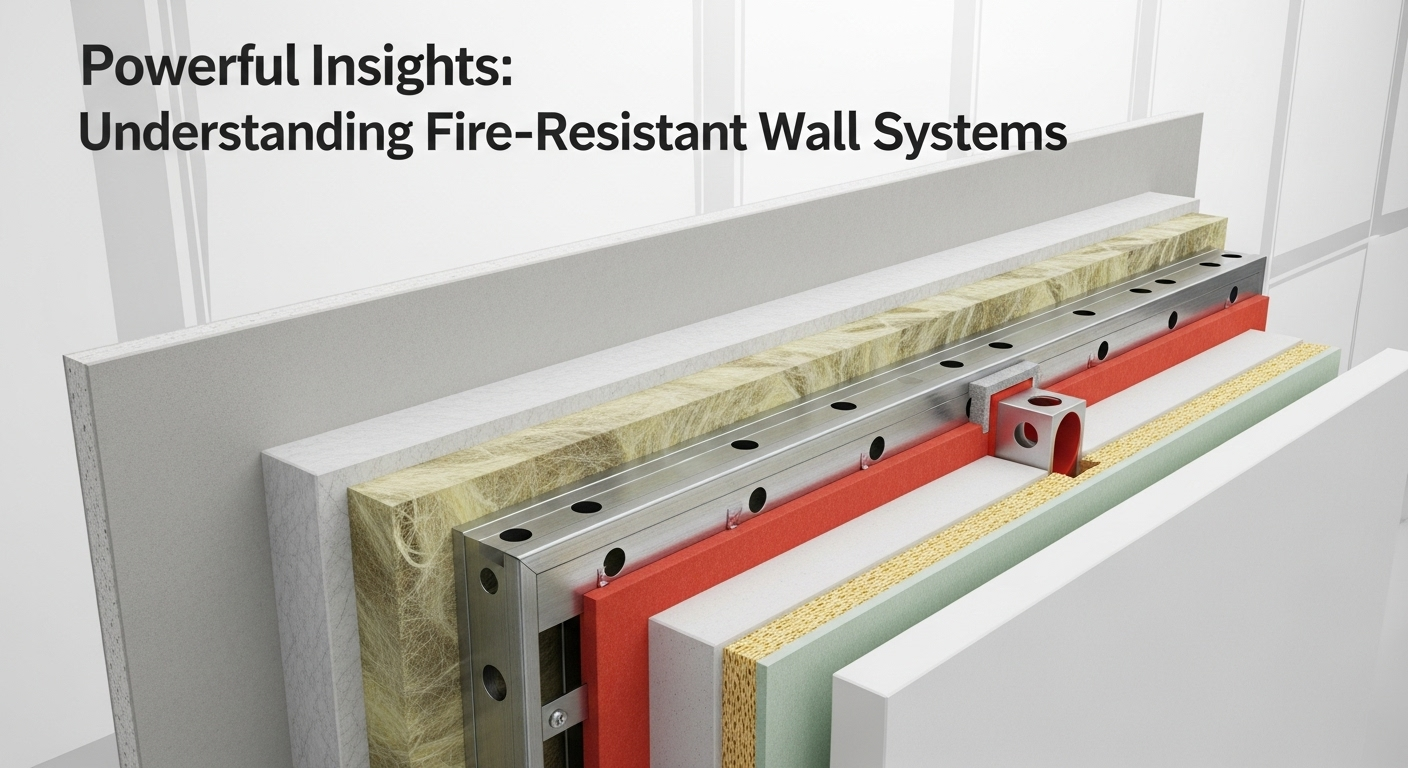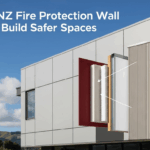The Fundamental Principles of Fire Resistance
Understanding Fire-Resistant Wall Systems – A foundational step in understanding fire resistant wall systems is clarifying a common misconception: the difference between fire-resistant and fireproof. No material is truly “fireproof” when subjected to enough heat for a sufficient duration. Instead, the building industry uses the term fire-resistant, which refers to an assembly’s ability to withstand fire and prevent its passage for a specific, rated period.
This resistance is measured against three primary performance criteria during standardized testing:
- Structural Integrity: The wall system must remain stable and continue to carry its load without collapsing under fire conditions.
- Insulation: The system must limit the temperature rise on the non-fire side of the wall. This prevents heat from igniting materials on the other side, effectively stopping the fire’s spread through thermal transfer.
- Integrity (Containment): The assembly must prevent the passage of flames and hot gases through cracks or openings that may develop during the fire.
A wall system must meet all three of these criteria for its entire rated duration to be considered fire-resistant. A failure in any one area means a failure of the entire assembly.

Decoding Fire Ratings and Building Codes
The effectiveness of a fire-resistant wall is not a matter of guesswork; it is a precisely measured and regulated characteristic. This standardization is what allows architects and engineers to design buildings with a predictable and reliable level of fire safety. A complete understanding of fire resistant wall systems is impossible without grasping how these ratings are determined and enforced.
What is a Fire-Resistance Rating?
A fire-resistance rating is the duration, typically measured in hours (e.g., 1-hour, 2-hour, 4-hour), for which a passive fire protection system can withstand a standard fire-resistance test. This rating quantifies how long a wall assembly will perform its three core functions—maintaining structural integrity, insulation, and containment—when exposed to a controlled fire.
These ratings are determined through rigorous testing protocols, the most common in North America being ASTM E119, “Standard Test Methods for Fire Tests of Building Construction and Materials.” During this test, a full-scale prototype of the wall assembly is built and subjected to extreme heat in a specialized furnace, with temperatures following a standardized time-temperature curve. Throughout the test, the assembly is monitored for any signs of failure in the three key criteria.
The Role of Building Codes and Standards
Fire ratings are not merely suggestions; they are mandated by law through building codes. Organizations like the International Code Council (ICC), which publishes the International Building Code (IBC), and the National Fire Protection Association (NFPA) set the requirements for where different fire-rated assemblies must be used.
Building codes dictate the necessary fire-resistance ratings based on several factors, including:
- Occupancy Type: A hospital or a school will have more stringent requirements than a warehouse.
- Building Height and Area: Larger and taller buildings require higher fire ratings to allow for longer evacuation times.
- Building Use: The walls separating residential units, enclosing exit stairwells, or protecting critical electrical rooms will have specific rating requirements.
These codes ensure a minimum standard of safety is applied consistently, making them a critical piece in the puzzle of understanding fire resistant wall systems from a regulatory perspective.
Understanding an Assembly, Not Just a Product
Perhaps the single most important concept in fire resistance is that the rating applies to the entire system, or assembly, not to a single component. A sheet of Type X gypsum board, for example, does not have a 1-hour fire rating on its own. The 1-hour rating is achieved by a specific combination of components constructed in a precise manner.
This assembly includes:
- The framing (wood or steel studs of a specific size and spacing).
- The insulation (if any).
- The gypsum board (type, thickness, and number of layers).
- The fasteners (type, length, and spacing of screws or nails).
- The joint finishing (tape and compound).
Any deviation from the tested and listed design—such as using the wrong type of screws, spacing them too far apart, or leaving joints unfinished—can compromise the integrity of the entire system and void its fire rating. This system-based approach is absolutely central to a proper understanding of fire resistant wall systems.
Common Types of Fire-Resistant Wall Systems
While countless configurations exist, most fire-resistant walls are constructed using a few key material types. Each has unique properties that contribute to its performance under fire conditions, and engineers select them based on the required rating, cost, and structural needs of the project.
Gypsum-Based Assemblies
Gypsum board, often referred to as drywall or wallboard, is the most common material used in modern fire-resistant wall construction. Its effectiveness comes from its chemical composition: gypsum is calcium sulfate dihydrate (CaSO₄·2H₂O), meaning it contains about 21% chemically combined water by weight.
When exposed to high heat, this water is slowly released as steam in a process called calcination. This process absorbs a significant amount of thermal energy, dramatically slowing the temperature rise on the other side of the wall. The steam also helps to dilute the combustible gases in the fire.
Type X and Type C Gypsum Board
While standard gypsum board offers some fire resistance, specialized versions are manufactured for enhanced performance:
- Type X Gypsum Board: This type features a specially formulated core with glass fibers reinforcing the gypsum. These fibers provide additional strength and cohesion, helping the core stay together longer as the water turns to steam and the gypsum dehydrates. A common 1-hour rated wall uses a single layer of 5/8-inch Type X board on each side of wood or steel studs.
- Type C Gypsum Board: For even higher fire ratings (2 hours or more), Type C gypsum board is often used. It contains vermiculite or other additives in its core that expand when heated. This expansion helps to compensate for the shrinkage that occurs during calcination, allowing the core to maintain its structural integrity for a longer period.
Shaft Wall Systems
A specialized and critical application of gypsum-based assemblies is the shaft wall. These systems are designed to enclose elevator shafts, stairwells, and vertical mechanical chases (ducts and pipes). Their unique challenge is that they often must be constructed from only one side.
Shaft wall systems typically use a “sandwich” design with layers of gypsum board on either side of special C-H studs. This allows contractors to build a highly fire-resistant enclosure from the floor side without needing access to the inside of the shaft, ensuring continuous fire protection between floors.
Concrete and Masonry Walls
Concrete and masonry are inherently non-combustible and possess excellent fire-resistant properties due to their mass and density. They can absorb and dissipate a large amount of heat without losing their structural integrity.
- Concrete Masonry Units (CMUs): Commonly known as cinder blocks, CMUs are a staple in fire-resistant construction. The fire rating of a CMU wall is primarily determined by its thickness and the type of aggregate used in the concrete mix. A standard 8-inch-thick CMU wall can easily achieve a 2-hour, 3-hour, or even 4-hour fire-resistance rating.
- Poured-in-Place Concrete: Reinforced concrete walls are also highly effective fire barriers. Their performance depends on the wall’s thickness and, crucially, the amount of concrete cover protecting the steel reinforcement. If the heat reaches the steel rebar and causes it to weaken, the wall could fail structurally. Therefore, codes specify a minimum concrete cover depth to ensure the steel remains insulated for the required rating period.

Critical Factors Beyond Materials: Installation and Maintenance
Specifying the correct materials and assembly design is only half the battle. The real-world performance of a fire-resistant wall is entirely dependent on proper installation and ongoing maintenance. A poorly installed system is an unreliable one, creating a false sense of security. An advanced understanding of fire resistant wall systems must include these practical considerations.
A key point of vulnerability in any fire-rated wall is penetrations. Walls must be breached for a building to be functional, allowing passage for pipes, electrical conduits, HVAC ducts, and communication cables. Each of these openings creates a potential path for fire and smoke to bypass the fire-resistant barrier.
To address this, a specialized field known as firestopping is employed. Firestop systems use a range of materials—including intumescent sealants, collars, mortars, and pillows—to seal the openings around penetrations. These systems are themselves tested and rated to match the rating of the wall they are installed in. A 2-hour wall with an unrated or improperly installed firestop around a pipe effectively has a 0-minute rating at that location.
Similarly, the treatment of joints between wall panels and at the top and bottom of the wall is critical. These gaps must be sealed with acoustical or fire-rated sealant to maintain the integrity of the assembly and prevent the passage of smoke and hot gases. Every detail, from the choice of fastener to the application of joint compound, contributes to the system’s overall performance. Regular inspections and maintenance are also essential to ensure that any damage or unsealed new penetrations are addressed promptly, preserving the wall’s fire-resistant capability over the life of the building.
Conclusion: A Holistic Approach to Fire Safety
Fire-resistant walls are far more than simple partitions; they are engineered life-safety systems designed with precision and tested for performance. From the microscopic water molecules in gypsum to the rigorous standards of building codes, every element plays a role in their ability to contain a fire and protect occupants.
A complete understanding of fire resistant wall systems reveals that true safety lies not in a single product, but in the holistic integration of correct design, tested materials, meticulous installation, and diligent maintenance. By appreciating the science behind fire ratings, the importance of code compliance, and the critical role of every component in an assembly, we can build structures that are not just functional, but fundamentally resilient and safe. This knowledge is non-negotiable for architects, engineers, contractors, and building managers committed to creating a safer built environment.






